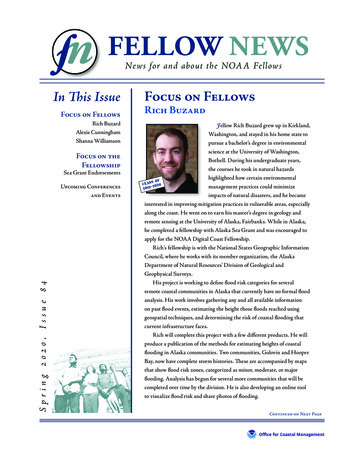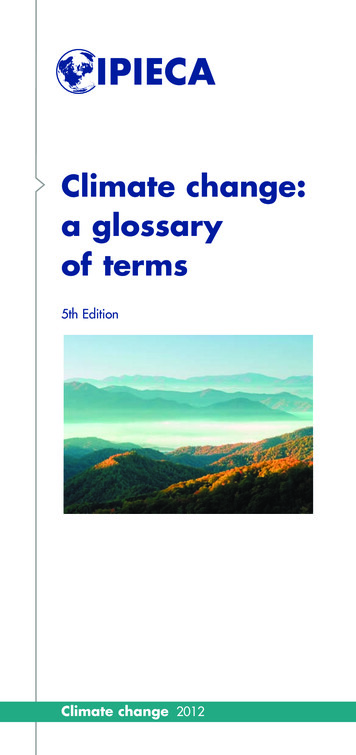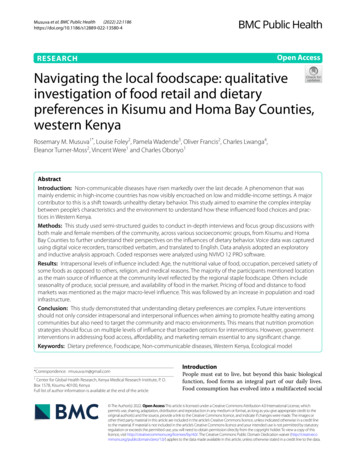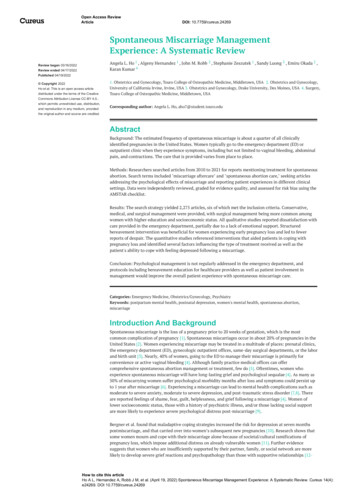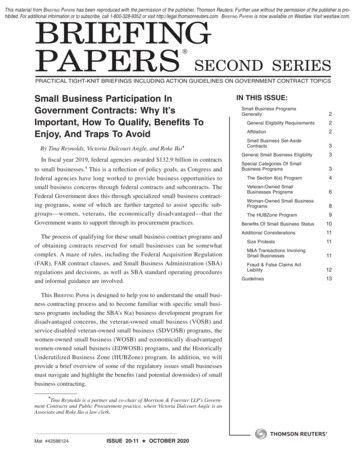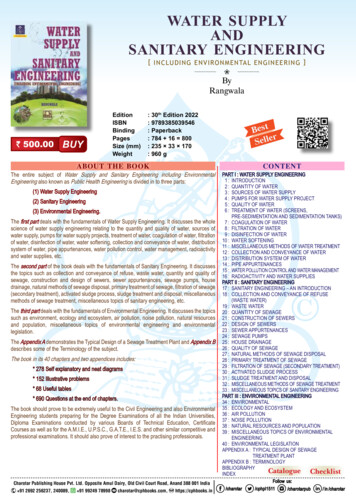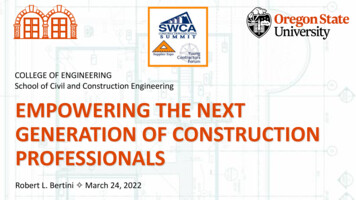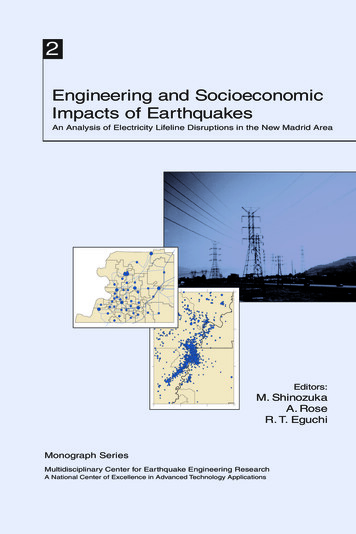
Transcription
2Engineering and SocioeconomicImpacts of EarthquakesAn Analysis of Electricity Lifeline Disruptions in the New Madrid AreaEditors:M. ShinozukaA. RoseR. T. EguchiMonograph SeriesMultidisciplinary Center for Earthquake Engineering ResearchA National Center of Excellence in Advanced Technology Applications
The Multidisciplinary Center for Earthquake Engineering ResearchThe Multidisciplinary Center for Earthquake Engineering Research (MCEER)is a national center of excellence in advanced technology applications that isdedicated to the reduction of earthquake losses nationwide. Headquartered atthe State University of New York at Buffalo, the Center was originally establishedby the National Science Foundation (NSF) in 1986, as the National Center forEarthquake Engineering Research (NCEER).Comprising a consortium of researchers from numerous disciplines andinstitutions throughout the United States, the Center’s mission is to reduceearthquake losses through research and the application of advanced technologies that improve engineering, pre-earthquake planning and post-earthquakerecovery strategies. Toward this end, the Center coordinates a nationwide program of multidisciplinary team research, education and outreach activities.Funded principally by NSF, the State of New York and the Federal HighwayAdministration (FHWA), the Center derives additional support from the FederalEmergency Management Agency (FEMA), other state governments, academicinstitutions, foreign governments and private industry.xxiv
i
ii
ENGINEERING AND SOCIOECONOMICIMPACTS OF E A R T H Q U A K E S:A N A N A LY S I S O F E L E C T R I C I T Y L I F E L I N EDISRUPTIONS IN THE NEW MADRID AREAiii
iv
ENGINEERING AND SOCIOECONOMICIMPACTS OF E A R T H Q U A K E S:A N A N A LY S I S O F E L E C T R I C I T Y L I F E L I N EDISRUPTIONS IN THE NEW MADRID AREAEdited byMasanobu ShinozukaAdam RoseRonald T. Eguchiv
Copyright 1998 by the Research Foundation of the State University of New Yorkand the Multidisciplinary Center for Earthquake Engineering Research. All rightsreserved.This mongraph was prepared by the Multidisciplinary Center for EarthquakeEngineering Research (MCEER) through grants from the National Science Foundation, the State of New York, the Federal Emergency Management Agency, andother sponsors. Neither MCEER, associates of MCEER, its sponsors, nor any person acting on their behalf:a. makes any warranty, express or implied, with respect to the use of anyinformation, apparatus, method, or process disclosed in this report or thatsuch use may not infringe upon privately owned rights; orb. assumes any liabilities of whatsoever kind with respect to the use of, orthe damage resulting from the use of, any information, apparatus, method, orprocess disclosed in this report.Any opinions, findings, and conclusions or recommendations expressed in thispublication are those of the author(s) and do not necessarily reflect the views ofMCEER, the National Science Foundation, Federal Emergency ManagementAgency, or other sponsors.Published by the Multidisciplinary Center for Earthquake Engineering ResearchUniversity at BuffaloRed Jacket QuadrangleBuffalo, NY 14261Phone: (716) 645-3391Fax: (716) 645-3399email: mceer@acsu.buffalo.eduworld wide web: http://mceer.eng.buffalo.eduISBN 0-9656682-2-3Printed in the United States of America.Jane Stoyle, Managing EditorHector Velasco, IllustrationJennifer Caruana, Layout and CompositionHeather Kabza, Cover DesignAnna J. Kolberg, Page Design and CompositionMichelle Zwolinski, CompositionCover Photograph provided by EQE, Inc.MCEER Monograph Number 2vi
F o r e w o r dEarthquakes are potentially devastating natural events whichthreaten lives, destroy property, and disrupt life-sustaining services andsocietal functions. In 1986, the National Science Foundation establishedthe National Center for Earthquake Engineering Research to carry outsystems integrated research to mitigate earthquake hazards in vulnerable communities and to enhance implementation efforts through technology transfer, outreach, and education. Since that time, our Centerhas engaged in a wide variety of multidisciplinary studies to developsolutions to the complex array of problems associated with the development of earthquake-resistant communities.Our series of monographs is a step toward meeting this formidable challenge. Over the past 12 years, we have investigated howbuildings and their nonstructural components, lifelines, and highwaystructures behave and are affected by earthquakes, how damage to thesestructures impacts society, and how these damages can be mitigatedthrough innovative means. Our researchers have joined together to sharetheir expertise in seismology, geotechnical engineering, structural engineering, risk and reliability, protective systems, and social and economic systems to begin to define and delineate the best methods tomitigate the losses caused by these natural events.Each monograph describes these research efforts in detail. Eachis meant to be read by a wide variety of stakeholders, including academicians, engineers, government officials, insurance and financial experts, and others who are involved in developing earthquake loss mitigation measures. They supplement the Center’s technical report seriesby broadening the topics studied.As we begin our next phase of research as the MultidisciplinaryCenter for Earthquake Engineering Research, we intend to focus our efforts on applying advanced technologies to quantifying building andlifeline performance through the estimation of expected losses; developing cost-effective, performance-based rehabilitation technologies; andimproving response and recovery through strategic planning and crisismanagement. These subjects are expected to result in a new monographseries in the future.I would like to take this opportunity to thank the National Science Foundation, the State of New York, the State University of Newvii
York at Buffalo, and our institutional and industrial affiliates for theircontinued support and involvement with the Center. I thank all the authors who contributed their time and talents to conducting the researchportrayed in the monograph series and for their commitment to furthering our common goals. I would also like to thank the peer reviewers ofeach monograph for their comments and constructive advice.It is my hope that this monograph series will serve as an important tool toward making research results more accessible to those whoare in a position to implement them, thus furthering our goal to reduceloss of life and protect property from the damage caused by earthquakes.George C. LeeDirector, Multidisciplinary Centerfor Earthquake Engineering Researchviii
C o n t e n t sForeword . viiPreface. xiiiAcknowledgments . xixAbbreviations . xxi1Introduction . 11.2by Adam Rose, Ronald T. Eguchi, and Masanobu ShinozukaBackground . 41.1.1 Brief History of Lifeline Earthquake Developmentsin the United States . 51.1.2 Federal and Industry Lifeline Initiatives . 10Overview . 102Modeling the Memphis Economy .132.12.22.32.42.52.62.7by Adam Rose and Philip A. SzczesniakHistory . 13Major Sectors of the Memphis Economy . 14Economic Indicators . 17Economic Interdependence and Interindustry Analysis. 18Memphis Input-Output Model . 22Regional Analysis of the Role of Utility Lifelines. 23Conclusion . 293Seismic Performance of Electric Power Systems .331.13.13.2by Masanobu Shinozuka and Howard H. M. HwangElectric Power System . 343.1.1 Conditions for System Failure . 343.1.2 Substation Model . 353.1.3 Monte Carlo Simulation . 38Conclusion . 43ix
44.14.24.35Spatial Analysis Techniques for Linking PhysicalDamage to Economic Functions .45by Steven P. FrenchDescribing the Local Economy . 47Spatial Analysis . 49Conclusion . 51Earthquake Vulnerability and EmergencyPreparedness Among Businesses .535.4by Kathleen J. Tierney and James M. DahlhamerMemphis/Shelby County Business Survey . 57Business Vulnerability . 585.2.1 Building Type and Business Location . 595.2.2 Lifeline Dependency . 605.2.3 Perceptions of the Earthquake Threat . 64Business Preparedness. 655.3.1 Adoption of Preparedness Measures . 655.3.2 Explaining Business Preparedness . 67Conclusion . 706Direct Economic Impacts .755.15.25.36.5by Stephanie E. ChangScope of Direct Economic Impacts . 75Current Estimation Methodologies . 78Conceptual Framework . 80Case Study: Electricity Disruption in NMSZ Earthquake . 816.4.1 Business Resiliency to Lifeline Disruption . 816.4.2 Location of Economic Activity . 856.4.3 Lifeline Service Disruption and Restoration . 866.4.4 Deterministic vs. Probabilistic Analysis . 886.4.5 Results . 91Conclusion . 927Regional Economic Impacts .956.16.26.36.47.17.27.3xby Adam Rose and Juan BenavidesEstimation of Total Regional Impacts . 967.1.1 Input-Output Impact Analysis . 967.1.2 Analysis of Simulation Results . 99Optimal Rationing of Scarce Electricity . 1027.2.1 Linear Programming . 1027.2.2 Analysis of Simulation Results . 1067.2.3 Policy Implications . 111Conclusion . 113
88.18.28.38.48.58.699.19.2.9.3Decision Support for Calamity Preparedness:Socioeconomic and Interregional Impacts . 125by Sam ColeModeling Economic Disasters . 127Construction of the Many-Region Accounts . 1288.2.1 Development of the Model . 1298.2.2 Representation as a Virtual GIS-based Model . 131Model Solution . 1348.3.1 Distributed Disruptions, TransactionCosts and Uncertainty . 134Memphis-Mississippi Valley Model . 1358.4.1 Memphis Region . 1358.4.2 Memphis Accounts . 137Application of the Decision Support System . 1418.5.1 Event Accounting Matrix . 1418.5.2 Base Scenario . 1418.5.3 Income Distribution and Interregional Impacts . 1488.5.4 Reallocation of Resources. 149Integration into Policy Making . 1508.6.1 Decision Support Systems Versus ExpertSystems . 151Implications for Effective Lifeline Risk ReductionPolicy Formulation and Implementation . 155by Laurie A. Johnson and Ronald T. EguchiStudy Implications. 157Towards Effective Lifeline Risk Reduction PolicyFormulation and Implementation. 1629.2.1 Policy Formulation Model . 162Conclusion . 168References .171Index . 183Contributors . 189xi
xii
P r e f a c eby Adam RoseThe potential losses from natural hazards, in terms of bothlives and property, are increasing. On the one hand, human action is now so pervasive as to intrude in a major way on theenvironment, even to the extent of causing climate change. Thismay manifest itself not only in terms of warming, but also climatevariability that increases the prevalence of strong winds andfloods. In contrast, our potential to affect the frequency of earthquakes is rather limited. Here the main concern is the other sideof the ledger—the continued population and economic build-up,which makes us increasingly more vulnerable even if the frequency of ground shaking does not increase.Our ability to cope with these issues thus requires an Integrated Assessment, ranging from geology and engineering toeconomics and policy. In-depth studies of this kind are, however, lacking in the earthquake field, and, for the most part, withrespect to other natural hazards. Our study is the first that hasattempted such an assessment of urban lifeline systems in relation to earthquakes.This monograph is a first-of-its-kind effort to remedy thesituation by developing and applying a multidisciplinary methodology that traces the impacts of a catastrophic earthquakethrough a curtailment of utility lifeline services to its host regionaleconomy and beyond. The New Madrid Seismic Zone is an appropriate case study because it is the site of the largest earthquakes to hit North America in recorded history. It has been thefocal point of extensive research, especially by scientists, engineers, and social scientists affiliated with the National Center forEarthquake Engineering Research over the first ten years of itsexistence. The study represents the culmination of many of theseefforts, which have often involved not only researchers but alsopublic officials, utility managers, company executives, and thepublic at large.xiii
Our objective is to improve the understanding of the detailed aspects and overall complexity of the problem. This monograph examines and connects the role of an electric utility andits host economy, the vulnerability of the lifeline network to acatastrophic earthquake, the business response to physical damage and production losses, the estimation of direct economiclosses, the estimation of indirect losses in the immediate region,and the manner in which these losses cause further ripple effectsto a broader metropolitan area and the rest of the U.S., as well asthe policy implications of all these interactions. The presentationof this monograph appears multidisciplinary rather than interdisciplinary—it is more like a relay race where each member haspicked up the baton from his or her predecessor. However, eachhand-off heightens our interdisciplinary understanding of the problem, and the effort as a whole is an integrated assessment.The ultimate aim of our study is to heighten awareness ofearthquake vulnerability and the interconnected nature of human actions. Our methods should help analysts sharpen theirvulnerability and loss estimates. It should also help private andpublic decision-makers make wiser choices about putting themselves at risk and about coping measures ranging from pre-disaster mitigation to post-disaster recovery. Obviously, the analysisis readily generalizable to both other types of lifelines and othernatural hazards.In addition to its practical usefulness, we also take prideas researchers in our ability to advance the state-of-the-art inseveral areas, both in terms of theory and empirical work. Examples include: An advanced vulnerability analysis of a major municipal electric utility system. The results of a major survey of perceived business disruptions. A GIS overlay of a major socioeconomic database and anelectric utility grid, capturing engineering features of electric utility lifelines and their linkages to the economy. Neglected features of input-output impact analysis relatingto the estimation of indirect effects, general input supplybottlenecks, resilience of production technology to electricity curtailment, and spatial differentials in electricity utilization.xiv
Formal optimization of scarce lifeline services across sectorsand sub-regions. A methodology to telescope economic impacts from the neighborhood to the national level. A new set of policy recommendations only ascertainable froman integrated assessment.The number of integrated assessment models of naturalhazards is on the rise. A major initiative was recently sponsoredby the National Institute of Building Sciences on behalf of theFederal Emergency Management Agency to develop an Earthquake Loss Estimation Methodology, referred to as HAZUS, andrelated efforts are currently underway to supplement this effortwith wind damage and flood damages modules. HAZUS is acomputerized system primarily for use by government agenciesat all levels to evaluate hazard mitigation, response, and recovery. System components range from ground-shaking throughphysical damage to the built environment to a translation intodirect dollar damage and then direct and indirect business disruption losses. Although HAZUS represents a major advance,for it to be operational it had to sacrifice modeling sophisticationof the type presented in this monograph. Also, more specifically,it is very limited in its treatment of lifelines, including only directphysical damage to lifeline structural components. It omits direct impacts on lifeline customers and ensuing economy-wideripple effects, as well as omitting considerations of optimal reallocation of scarce lifeline resources so as to minimize production and employment losses. We hope that our monograph willprove useful in remedying these omissions in the HAZUS software and other practical approaches to emergency managementin the future. At the same time, we intend that our work willprovide engineering and socioeconomic insights that will helpstreamline loss estimation methods for complex systems in general.This study will prove useful to several categories of readers. While the probabilities of large earthquakes are highly uncertain, the potentially overwhelming economic impacts (bothregionally and nationally) cannot be ignored. This study shouldprove provocative to even experienced public utility managers.It provides compelling evidence for considering a long-term riskmanagement strategy to reduce earthquake vulnerability. Further, it demonstrates the significance of economic impacts in-xv
duced by lifeline damage and the importance of considering themin designing socially responsible risk management strategies.Insurance companies might also be interested in our methodologies to quantify indirect losses. There may be a marketdemand for insurance riders that cover business interruption lossesresulting from both direct damage to a facility or building, andfrom external factors, such as loss of electric power service orunavailability of other inputs. This coverage is not generally offered because of the lack of actuarial experience to assess risk.The methods developed in this study could be used to calculatethe potential magnitude of these losses, and then used in establishing a credible insurance structure. As a result, insurance companies might be better able to offer business interruption coverage on a broader basis.Business executives could gain insight to earthquake preparedness from their counterparts in Memphis in terms of an assessment of vulnerability and identification of coping measures.They might also gain a greater appreciation of theinterconnectedness of the economy in which they operate andits ramifications. For example, paying a premium for non-interruptible electricity service may not insure continued operation ifa supplier of another critical input opts not to pay the premiumand is not able to produce and hence deliver its product.We also hope that the analysis will be useful to our fellowresearchers in the earthquake field, as well as other hazards.We make no pretense that we have exhausted research advances needed to adequately address these issues, and henceencourage others to build on our work.The research in this monograph has endeavored to improve our perspectives on time and space in relation to hazards.It has imparted spatial dimensions to economic models, wherethese are usually lacking. This is a key link between the physicalworld and the human settlement system. On a temporal side, theresearch emphasis on production losses helps heighten awareness that an earthquake event is not confined to the period ofground shaking and structural damage, but to the longer periodduring which the socioeconomic system is unable to prevail atpre-earthquake levels. This is key in making the transition fromstructural to nonstructural (societal) aspects of earthquakes.Finally, an overall theme of this monograph is that natural hazards accentuate scarcity, thus making resources even morexvi
valuable than before. Our limited resources must be balancedwisely between pre-disaster mitigation and post-disaster recovery. Just as emergency medical, fire, and other safety servicesmust be well managed in the aftermath of a disaster, so too shouldlifeline services. This calls for major reallocations of resources,which may be controversial from a political standpoint. However, our analysis indicates that savings from prioritizing electricity service among those with the lowest intensities of electricity use directly and indirectly (after safeguarding for health,safety, and essential industry) can reduce losses of goods andservices several-fold. As the author of one of the chapters notes,not taking advantage of such opportunities results in an outcomeas devastating as if the earthquake had actually toppled the buildings in which the lost production would have originated.xvii
xviii
AcknowledgmentsThe papers in this monograph resulted from multi-year,multidisciplinary research sponsored by the National Center for Earthquake Engineering Research. The researchers gratefully acknowledgethe assistance of many individuals who contributed to the project. Inparticular, we would like to thank Dr. Woody Savage, Pacific Gas andElectric Company; Mr. Tom Durham, Central United States EarthquakeConsortium; Dr. Anshel Schiff, Stanford University; Dr. Satoshi Tanaka,Kyoto University; and Mr. Tommy Whitlow and Mr. Bill Sipe, MemphisLight, Gas and Water (MLGW) Division, City of Memphis, for their helpful suggestions. We are also indebted to MLGW and the Shelby CountyPlanning Department for access to their data.We owe a great debt to the staff of the National Center for Earthquake Engineering Research, especially its Director, Dr. George Lee,and its Publication Manager, Jane Stoyle, who did such a fine job duringthe various stages of this monograph’s production. We benefitted greatlyfrom the helpful suggestions of several anonymous reviewers contactedby NCEER to assess the suitability of our manuscript for publication. Thefinancial support of NCEER’s sponsors, the National Science Foundationand the State of New York, is also gratefully acknowledged. Several ofthe authors also benefitted from supplemental finding from related NSFgrants and other sources.Many of the authors benefitted from clerical support at their institutions/organizations. However, the word processing and coordinationefforts of Jan Moyer of The Pennsylvania State University deserve special mention.Perhaps our greatest debt is to our departed friend and colleague,Barclay Jones, who was a stalwart among NCEER researchers for manyyears. Barclay, perhaps more than anyone, worked to bridge the gapbetween engineers and social scientists. Without his pioneering efforts,this interdisciplinary monograph would not have been possible.xix
xx
A b b r e v i at i o n sASCEATCAmerican Society for Civil EngineersApplied Technology CouncilBEPCBSSC(Memphis) Business Emergency Preparedness CouncilBuilding Seismic Safety CouncilCBCTPPCUREeCUSECCircuit BreakerCensus Transportation Planning PackageCalifornia Universities for Research in EarthquakeEngineeringCentral U.S. Earthquake ConsortiumDRCDSSDisaster Research CenterDecision Support SystemEAMEERIEPRIEPSAESRIEvent Accounting MatrixEarthquake Engineering Research InstituteElectric Power Research InstituteElectric Power Service AreaEnvironmental Systems Research InstituteF.I.R.E.FEMAFinance, Insurance and Real EstateFederal Emergency Management AgencyGAMSGISGRPGeneral Algebraic Modeling SystemGeographic Information SystemGross Regional ProductHHHouseholdIMPLANI-OIRSImpact Analysis for Planning SystemInput-OutputInternal Revenue ServiceLPLinear Programmingxxi
ary Center for Earthquake EngineeringResearchMemphis Light, Gas and Water DivisionMathematical ProgrammingMetropolitan Statistical AreaMegawattsNEHRPNIBSNISTNMSZNRCNSFNYSSTFNational Center for Earthquake Engineering ResearchNational Center for Geographic Information andAnalysisNational Earthquake Hazards Reduction ProgramNational Institute of Building SciencesNational Institute of Standards and TechnologyNew Madrid Seismic ZoneNational Research CouncilNational Science FoundationNew York State Science and Technology FoundationPGAPOLAPeak Ground AccelerationPort of Los AngelesRMSRisk Management SoftwareSAMSBASEMSSICSocial Accounting MatrixSmall Business AssociationStandardized Emergency Management SystemStandard Industrial ClassificationTAZTCLEETCUTVATVPPATraffic Analysis ZoneTechnical Council on Lifeline Earthquake EngineeringTransportation, Communications and UtilitiesTennessee Valley AuthorityTennessee Valley Public Power Associationxxii
21Introductionby Adam Rose, Ronald T. Eguchiand Masanobu ShinozukaThe largest earthquakes ever to hit North America were centered in the New Madrid Seismic Zone near Memphis, Tennessee,in 1811-12. Reports of these events were phenomenal. Riverswere rerouted, trees were said to have popped right out of theground, and the ground shaking itself was felt as far away as Boston (Pinick, 1981; Fuller, 1990). Yet, total dollar damages associatedwith the earthquakes were probably less than 1 million. Thereason is that the area was relatively uninhabited, the city of Memphis, for example, not being founded until several years later.How would the situation differ today? An earthquake of asimilar or even lesser magnitude is projected to be able to causedamage in the billions of dollars. The difference is that the Memphis area is now highly populated and is the center of asophisticated and highly-interdependent regional economy. Moreover, it is also a major crossroads for the national economy.Earthquake events are what natural hazards expert Robert Kates(1971) refers to as a “joint interaction phenomenon”—a combination of a physical stimulus and the human settlement system.Both are necessary for disaster to take place. The 1811-12 earthquakes are much like the old philosophical conundrum: if a treefalls in the forest and there is no one around, is there a noise?Similarly, in an area with a small population and little economicactivity, an earthquake is not very meaningful.This is much the rationale for the interdisciplinary nature ofthis monograph. A study of earthquake impacts requires knowledge of geological origins, but also of the engineering realities ofstructures and their vulnerabilities, the workings of the economy,the sociology of individuals and organizations, and the politicsand planning of mitigation, recovery, and reconstruction.1
This monograph presents an integrated study of the implications of an electricity lifeline disruption caused by a majorearthquake in the New Madrid Seismic Zone. Scientists do notplace a strong likelihood of a reoccurrence of an earthquake themagnitude of the 8.5M event of the previous century in the Memphis area in the near future. Therefore, a 7.5M event was used asthe basis for this study. Note that high levels of damage to lifelinesand other features of the human use system can take place at evenlesser magnitudes as witnessed by the recent Kobe and Northridgeearthquakes. The methodology in this monograph, therefore, hasmore general applicability in terms of earthquake magnitude. Inaddition, it can provide insights into earthquake impacts in otherloca
Engineering and Socioeconomic Impacts of Earthquakes Editors: M. Shinozuka A. Rose R. T. Eguchi An Analysis of Electricity Lifeline Disruptions in the New Madrid Area 2 Monograph Series Multidisciplinary Center for Earthquake Engineering Research A National Center of Excellence in Advanced Technology Applications

